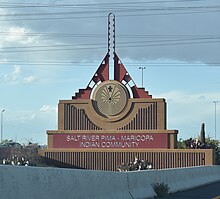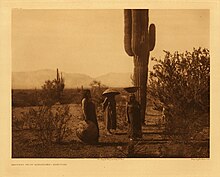Ethnic group
| Onk Akimel O'odham (O'odham) Xalychidom Piipaash (Maricopa) | |
|---|---|
 SRPMIC Seal SRPMIC Seal | |
| Total population | |
| 9,357 | |
| Regions with significant populations | |
| United States (Arizona) | |
| Languages | |
| Akimel O’odham, Xalchidom Piipaash, and English | |
| Religion | |
| Traditional beliefs, Christianity | |
| Related ethnic groups | |
| other Akimel O’odham and Maricopa tribes, Tohono O'odham |



The Salt River Pima–Maricopa Indian Community (SRPMIC) comprises two distinct Native American tribes—the Pima (O'odham language: Onk Akimel O'odham, meaning "Salt River People") and the Maricopa (Maricopa language: Xalychidom Piipaash, meaning "people who live toward the water")—many of whom were originally part of the Halchidhoma (Xalchidom) tribe. The community was permanently created by an Executive Order of US President Rutherford B. Hayes on June 14th, 1879. The community area includes 53,600 acres (217 km), of which 19,000 remain a natural preserve. As of 2022, the total population is 7,386. The community is a federally recognized tribe located in Arizona.
The community borders the Arizona cities of Scottsdale, Mesa, Tempe, and Fountain Hills.
The Great Seal of the Salt River Pima–Maricopa Indian Community is a representation of I'itoi, commonly referred to as the Man in the Maze.
Historical Background
The O'odham (Pima) and Pipaash (Maricopa) peoples lived in villages along the Gila River when settlers began to arrive. Due to the settlers removing so much water from the upstream of the River, many O'odham migrated to the Salt River Valley where there was relatively more water. Conflicts over resources and hostility between the settlers and O'odham resulted in the government establishing the reservation "as a temporary measure to protect Indian rights."
Business enterprises
Since the late 20th century, the community has owned and operated two casinos on its land (Talking Stick Resort), both operating under the Casino Arizona brand name. The facilities attract gamblers from the local Phoenix area as well as out-of-state tourists.
In February 2011, the community opened the first Major League Baseball spring training facility on Indian land, Salt River Fields at Talking Stick. This 140-acre (57 ha) baseball complex is the spring training home of the Arizona Diamondbacks and Colorado Rockies.
The community owns and operates the Phoenix Cement Company, which supplies northern Arizona and Phoenix with cement and related products. The company's plant, one of only two large cement manufacturers in Arizona, is in Clarkdale.
The eastern leg of the Loop 101 freeway (Pima freeway) passes through the western edge of the community in a north/south alignment. Both sides of the freeway and all four corners of each interchange within the community are in the domain of the community for development purposes. The alignment of the freeway across community land was a contentious issue within the community and between the community and local and state transportation officials throughout the 1980s.
The streets and roads in the community generally follow the same street grid of the surrounding cities in the Phoenix metropolitan area, such as Phoenix, Scottsdale, and Mesa. Most are two-lane rural roads and are widened somewhat in certain spots to serve vehicular traffic for the casinos and other business enterprises.
Language
The Salt River Pima–Maricopa Indian Community supports the preservation of the Akimel O’odham and Xalchidom Piipaash languages through teaching and learning for everyone within the Community. It encourages all community members to preserve the Akimel O’odham and Xalchidom Piipaash languages within their homes (Council Resolution SR-2026-2000).
Some tribal employees, who work within the community, take language classes so they have a better understanding of the community and people and have a better working relationship with the people they serve. Some learners want to learn more about their own culture, pass on language to their children, and know more about who they are. Some want to learn so they can understand whether their aunts or parents are talking about them.
Extreme poverty, school dropout, drug use, and border issues have also claimed attention within the tribe, hindering progress of language revitalization. Language activists are looking to reverse the language endangerment in their community but a commitment to the goal is needed for them to continue.
Government
The Salt River community is governed by an elected President, Vice President, and Tribal Council after the tribe adopted its own 1940 constitution under the federal Indian Reorganization Act (IRA) of June 18, 1934. Current President and Vice President are Martin Harvier and Ricardo Leonard, respectively. Current council members include Archie Kashoya; Cheryl Doka; Diane Enos; Thomas Largo, Sr.; Deanna Scabby; Michael Dallas, Sr.; and Wi-Bwa Grey.
Man in the Maze
Main article: I'itoiCentral to the beliefs of the Salt River Pima–Maricopa Indian Community is the story of the Man in the Maze, or I'itoi ki:k, which is the symbol seen on the great seal. This ancient pattern (visible at the right) is representative of the journey a person makes through life, including obstacles and problems. The figure is called Elder Brother and he is about to make his way through the maze. At the center, he will find the Sun God, who is there to greet him and bless him into the next world. The symbol belongs to the Akimel O’odham (Pima), Pee-Posh (Maricopa), and Tohono O'odham tribes and is traditionally represented in ancient petroglyphs and traditional basket designs.
Education

There is a tribal elementary school, Salt River Elementary School, affiliated with the Bureau of Indian Education (BIE). Public school districts incorporating parts of the reservation include Mesa Public Schools, with Westwood High School being the zoned high school.
Prior to 1974 the Scottsdale Unified School District accepted students from the reservation. In 1965 400 students attended the Mesa school district facilities. In 1974 the Scottsdale district began rejecting residents of the reservation. In 2000, a total of 1,120 students from the reservation attended Mesa schools.
Some time prior to 2000, the Bureau of Indian Affairs (BIA) operated the Salt River tribal school, but it later became tribally controlled.
A charter school with secondary students, Desert Eagle School, opened in 1995. Desert Eagle was converted into Salt River High School, which opened in 2004.
The tribal elementary school and Salt River Accelerated Learning Academy, a charter high school, which functions as an alternative school for students deemed "at-risk", are, along with the former Salt River High School, part of the Salt River Pima-Maricopa Community Schools system, or Salt River Schools. All of the schools have coursework related to the Maricopa (Piipash) and O'odham peoples. In particular, in 2020, students in the seventh grade took mandatory O'odham language classes.
Cemetery
The community maintains a cemetery near E. McDowell Road.
Church of Jesus Christ of Latter-day Saints
The Salt River Pima-Maricopa Indian community is home to the oldest continuous Native American congregation of the Church of Jesus Christ of Latter-day Saints (the Papago ward). In 1997, the church building was rededicated with a ceremony. The newly renovated LDS Mesa Temple Visitors' Center includes a display of the history of the origins of the Salt River community.
Notes
- "Salt River Pima-Maricopa Indian Community of the Salt River Reservation, Arizona". Native American Advancement, Initiatives, and Research. June 25, 2021. Retrieved February 22, 2022.
- Comeaux, Malcolm L. (July 1, 1991). "Creating indian lands: the boundary of the salt river indian community". Journal of Historical Geography. 17 (3): 241–256. doi:10.1016/S0305-7488(05)80001-5. ISSN 0305-7488.
- "Salt River Fields at Talking Stick". MLB.com. Archived from the original on November 11, 2016. Retrieved September 29, 2017.
- "Phoenix Cement: 50 & Growing". Verde Independent. Western News&Info. April 14, 2009. Archived from the original on December 3, 2013. Retrieved March 20, 2013.
- Lynch, Ken (October 3, 2017). "Loop 101 101: How One Man Stalled The Freeway for 8 Years and Changed a Tribe Forever".
- "History and Culture". SRPMIC. Retrieved February 16, 2022.
- "Salt River Pima-Maricopa Indian Community | Inter Tribal Council of Arizona". itcaonline.com. Retrieved February 16, 2022.
- "The SRPMIC Great Seal". Retrieved September 29, 2017.
- Ramon-Sauberan, Jacelle "Several Tribes Share the Man in the Maze" Archived February 21, 2009, at archive.today, Rez Net News. February 15, 2009 (retrieved September 9, 2010)
- "Salt River Elementary School". Bureau of Indian Education. Retrieved June 4, 2023.
11562 East Highland Ave, Scottsdale, AZ, 85256
- ^ Cadeau, Chimene (April 5, 2000). "Salt River Community has school of its own". The Arizona Republic. Phoenix, Arizona. p. Schools 6. - Clipping from Newspapers.com.
- Mishory, Jordana (August 16, 2004). "New Salt River high school opens today". The Arizona Republic. Phoenix, Arizona. p. B4. - Clipping from Newspapers.com.
- "Salt River Accelerated Learning Academy". National Center for Education Statistics. Retrieved June 5, 2023.
- "About". Salt River Accelerated Learning Academy. Retrieved June 5, 2023.
- "Salt River Pima-Maricopa Community Schools (4320)". National Center for Education Statistics. Retrieved June 6, 2023. - NCES does not list the elementary school as part of the network.
- "Home". Salt River Schools. Retrieved June 6, 2023. - The Salt River Schools site does list the elementary school as a part of the network.
- Christiansen, Andrew Diaz; Rice, William (January 10, 2020). "Salt River students discover ancestral roots through language, weaving". Cronkite News. Retrieved June 5, 2023. - See summary at Pinal Central.
- Turner, D. L. (2013). "Akimel Au-Authm, Xalychidom Piipaash, and the LDS Papago Ward". Journal of Mormon History. 39 (1): 158–180. doi:10.2307/24243746. ISSN 0094-7342. JSTOR 24243746. S2CID 254480653.
- "Pres. Hinckley shows 'great love for sons, daughters of Lehi'". Church News. September 20, 1997. Retrieved February 22, 2022.
- "Visitors' Center". MesaTemple.org. Retrieved February 16, 2022.
References
- Salt River Pima–Maricopa Indian Community, Community Council Resolution: SR-2026-2000, August 16, 2000
External links
| See also: Indigenous peoples of Arizona |
| Municipalities and communities of Maricopa County, Arizona, United States | ||
|---|---|---|
| County seat: Phoenix | ||
| Cities |  | |
| Towns | ||
| CDPs | ||
| Populated places |
| |
| Indian reservations | ||
| Ghost towns/ former populated places | ||
| Footnotes | ‡This populated place also has portions in an adjacent county or counties | |
| Phoenix metropolitan area | |
|---|---|
| Core city | |
| Largest suburbs (over 100,000 inhabitants) | |
| Other suburbs and towns (over 10,000 inhabitants) | |
| Smaller suburbs and towns (over 5,000 inhabitants) | |
| Exurbs | |
| Counties | |
| Native American reservations | |
| Subregions | |
33°31′13″N 111°47′36″W / 33.52028°N 111.79333°W / 33.52028; -111.79333
Categories: